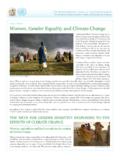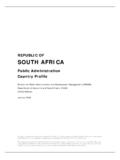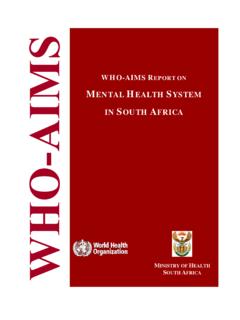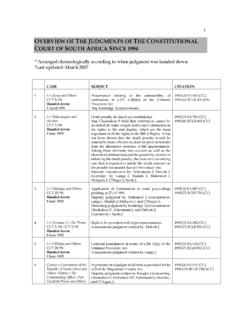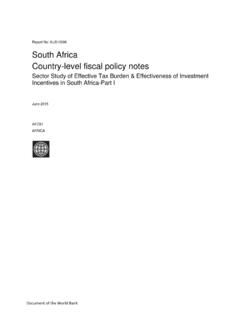Transcription of FERTILITY TRANSITION IN SOUTH AFRICA AND ITS …
1 FERTILITY TRANSITION IN SOUTH AFRICA AND ITS IMPLICATIONS. ON THE FOUR MAJOR POPULATION GROUPS. Leon Swartz . A. I NTRODUCTION. In general there seems to be widespread agreement that FERTILITY began to decline among all major population groups in SOUTH AFRICA prior to the end of apartheid. It occurred at a much faster level for Whites and Asians as compared to Africans and Coloureds. This occurred amidst the impoverishment of millions (especially African women), stark inequalities and the disempowerment of women. Although SOUTH AFRICA has undergone a dramatic political TRANSITION in the last decade, many of the distortions and dynamics introduced by apartheid continue to reproduce poverty and perpetuate inequality.
2 The SOUTH African population policy (Dept. of Welfare, 1998) argues that the basic demographic factors FERTILITY , migration and mortality are an integral part of poverty prevalence in SOUTH AFRICA . These demographic factors cannot be seen in isolation from social factors such as education, unemployment, poor health and housing quality and their interrelationships with poverty. Thus, on the one hand, poverty persists, while on the other hand, FERTILITY declines. This is in stark contrast to the experience in other parts of sub- Saharan AFRICA , where poverty usually goes hand in hand with high FERTILITY . This paper investigates issues around lower FERTILITY , factors contributing to it, its impact on the different population groups as well policies to address its impact.
3 1. SOUTH AFRICA 's FERTILITY compared to Sub-Saharan AFRICA Figure I clearly illustrates that the SOUTH African FERTILITY rate is significantly lower than that of other countries in Southern and East AFRICA . A steady decline in FERTILITY in developing nations took place in the late 1980s and 1990s, especially in the regions of Asia and Latin America. In contrast, AFRICA and particularly sub-Saharan AFRICA still lag behind in FERTILITY terms. Reasons for SOUTH AFRICA 's low FERTILITY compared to its neighbours is multifaceted which will be explained, later in more detail. B. SOUTH AFRICA 'S FERTILITY TRENDS. SOUTH AFRICA 's experience in the FERTILITY TRANSITION is among the most advanced in sub-Saharan AFRICA .
4 SOUTH AFRICA displays demographic regimes that are typical of both developed and developing worlds. These tend to be linked to socio-economic divisions along racial and urban-rural lines. Living standards are closely correlated with race in SOUTH AFRICA . While poverty is not confined to any one racial group in SOUTH AFRICA , it is concentrated among Africans in particularly. Many of the apartheid measures, including the extensive welfare system available to White people, the higher quality of education available to White students, and the formal and informal job reservations for White workers, was specifically designed in preventing poverty among the White population. As shown in figure II, poverty among Whites is close to zero.
5 On the contrary, poverty among Africans', the most disadvantaged group stands at 60,7 per cent compared to 38,2 per cent, and 5,4 per cent for Coloureds and Asians. It is interesting to note, however, that the very few poor Asians and Whites also seem to be at a considerable distance below the poverty line.. Deputy Director, Intergovernmental HIV/Aids Research Collaboration, Chief Directorate Population and Development, Department of Social Development, Republic of SOUTH AFRICA . 539. With Africans making up 77 per cent of the population, their high incidence and severity of poverty amongst them ensures that they account for 95 per cent of the poverty gap, with the remaining 3.
6 Per cent largely accounted for the poverty among Coloureds with the 1 per cent each shared by the Asians and Whites, respectively as shown in figure III. The differences in poverty by race also contribute to the distribution of poverty by location since the racial groups were unevenly distributed in the country. At the same time, among Africans, the group compr ising nearly all the country's poor, the pattern of much higher poverty in rural areas and the concentration of poverty in the former homelands and some of the provinces still holds. The FERTILITY trends among population groups in SOUTH AFRICA shows the same patterns as that of poverty. The African component which is the poorest with regard to per capita income has the highest FERTILITY rate, while the White population which has the highest per capita income has the lowest FERTILITY rate as explained below.
7 Thus, among all the four major racial groups in SOUTH AFRICA a decline of FERTILITY has been observed from as early as the 1960s. Figure IV shows that the swiftest decline occurred among the coloureds, followed by Africans. For SOUTH AFRICA as a whole, FERTILITY was high and stable between 1950 and 1970, estimated at an average of 6 to 7 children per woman. It dropped to an average of 4 to 5 children per woman in the period 1980 to 1995 (United Nations, 95). The current total FERTILITY rate of SOUTH AFRICA stands at 2,9 (SADHS, 1999). Whites experienced a long and sustained FERTILITY decline from the end of the 19th century until attaining below-replacement FERTILITY by 1989, with a TFR of 1,9 (Chimere-Dan, O, 1993).
8 Asian FERTILITY also declined steadily, from a TFR of about 6 in the 1950s to 2,7 in the late 1980s. Coloured FERTILITY declined remarkably rapidly from 6,5 in the late 1960s to about 3 by the late 1980s. African FERTILITY is estimated to have decreased from a high of 6,8 to a low of about 3,9 between the mid-1950s and the early 1990s. Although it continues declining, African FERTILITY is still substantially higher than that of the other racial groups. 1. Reasons for FERTILITY decline? However despite this dramatic decline in FERTILITY the majority of African population, especially women still lives in poverty. The question that we, however, need to ask is, How did this FERTILITY TRANSITION came about ?
9 A) SOUTH African past Population policies This question will be answered by investigating the government's past population policies. The government began to provide strong support for family planning in the 1960s. This support was driven by the fear that rapid population growth would undermine SOUTH African prosperity and economic development, but also by concern among white political leaders and administrators that the fast growing African population would overwhelm the much smaller number of whites. As early as 1963, the apartheid government provided substantial funding for private and public family planning services and furnished free contraceptives. In 1974, the SOUTH African government launched the well-funded National Family Planning Programme.
10 The results were impressive and unprecedented in sub-Saharan AFRICA . By 1983, over half the eligible women in the country were practicing contraception. Despite the aim to lower the African population the government at the same time was encouraging an increase in the white population through immigration. 540. The programme consequently came under much pressure, both for its ideological focus and the inadequacy of its services. By mid-1980s the programme's management had distanced itself from the demographic intent of the Population Development Programme (PDP). Instead, it promoted the programme's health benefits and started to integrate family planning into other primary health care services.









